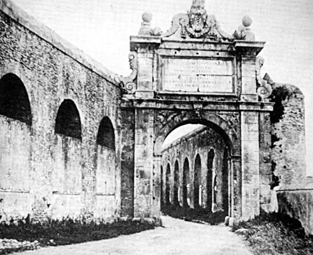Acquedotto Traiano-Paolo
42 03 12.9 N, 12 20 18.7 E

The Acquedotto Traiano-Paolo, the original aqueduct built by the Emperor Trajan, circa 110 AD, was a symbol of the advanced infrastructure of ancient Rome. It continues to provide water for the fountains of Rome. "[Of] the great ancient aqueducts whose ruins truly command respect, ... what a great and noble purpose is that of bringing a people to drink by way of such a magnificent monument."
— German poet Johann Wolfgang von Goethe, in his diary October 29, 1786
The Roman emperor Trajan ordered a new aqueduct be built to bring fresh water to Italy's Trastevere region and parts of Rome. The water is collected from five springs that feed the lake at Bracciano, and traverses over 25 miles into Rome. To maintain an even gradient, the aqueduct follows a meandering alignment through the countryside to avoid hills and major valleys. The water runs through an open-channel canal that is either arch-supported, at-grade, or underground. Even though enemies of the Roman Empire destroyed portions of the aqueduct, it has been rebuilt several times over the past 2,000 years and continues to supply water to the fountains of Rome.
Facts
- Water flows through an open channel 0.9 meters wide by 1.3 meters deep.
- The aqueduct is 57,000 meters long and some of the arch-supported segments across valleys are more than 33 meters high.
- The original structure was constructed of concrete with a few cut stones at the bottom and faced with two broad bands of brick, likely broken roof tile.

